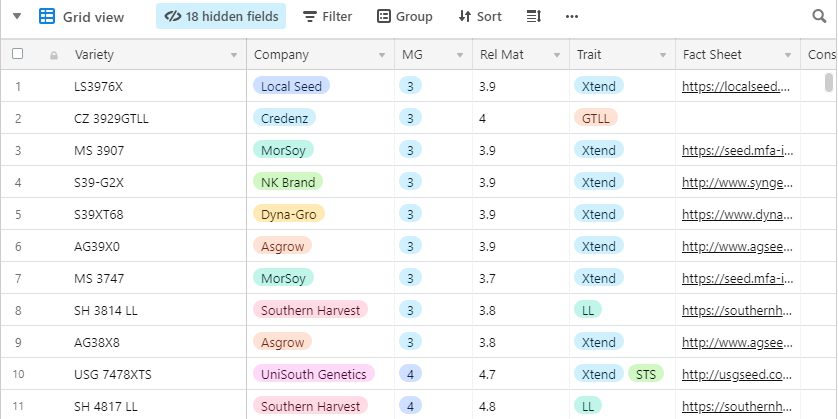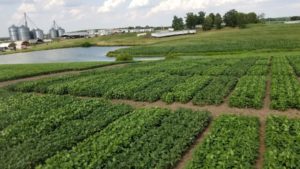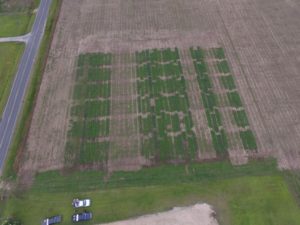Proper variety selection is one of the most important steps a soybean producer can make. It is important to devote some time to selecting the proper variety as this decision is one of the first steps to maximizing yields.
If we compare the top 10% of soybean varieties grown within a single maturity group at a single location in the OVT to the bottom 10%, we can see as much as a 15 bu/ac difference in yield.
At 9-dollar beans, that could result in a loss of over $100/acre, not a small mistake!
Selecting the right variety for the right environment is essential, but with more than 200 soybean varieties available to NC growers, this can be an overwhelming decision. Each variety has specific strengths and weaknesses that make it more- or less-suited for a given environment.
To help aid your Variety Selection process, we have created a Variety Selection Tool. The tool can be found here and a tutorial on how to use the tool can be found here.
Below are some things to consider when selecting a variety for your operation.
MATURITY GROUP
One of the first steps in variety selection is to choose your relative maturity. Even if you plan to plant a range of maturities, focus on one relative maturity at a time to help reduce the list of options. Understanding and selecting the appropriate maturity for a given area is critical to maximizing soybean yield. A variety is classified based on the geographical range where it utilizes the available growing season but still reaches physiological maturity before the first frost. As Dr. Dunphy has famously said, you need a variety that is “at least 3 feet tall and laps the middles”. There are a number of maturity group by planting date combinations that will achieve this in North Carolina. Dr. Rachel Vann and the NC State Soybean Extension Program are currently evaluating various combinations and will have a robust dataset to help you with this decision in a few years.
HERBICIDE TOLERANCE TECHNOLOGY
The next step in choosing a variety is to select the herbicide tolerance trait(s) you plan to use. The majority of soybeans grown in the United States contain at least one genetically-engineered herbicide tolerance trait. Herbicide tolerant classes include Roundup Ready (RR), Roundup Ready 2 Yield (RR2), Liberty Link (LL), sulfonylurea-tolerant soybeans (STS), Xtend, and 2,4-D (Table 4-1). The RR, RR2, LL, Xtend, and 2,4-D traits are genetically modified, while the STS trait was developed using conventional methods and is not considered genetically modified.
| Seed | Trait |
| Roundup Ready 1 (RR) or Glyphosate Tolerance (GT) | Tolerance to glyphosate |
| Round Ready 2 | Tolerance to glyphosate |
| Roundup Ready 2 Xtend | Tolerance to glyphosate and dicamba |
| Xtendflex | Tolerance to glyphosate, dicamba, and glufosinate |
| LibertyLink | Tolerance to glufosinate |
| LL GT27 | Tolerance to glufosinate, glyphosate, and HPPD/Group 27 |
| Enlist E3 | Tolerance to glyphosate, 2,4-D, and glufosinate |
| STS | Tolerance to slufonylurea herbicides |
DISEASE TOLERANCE
Tolerance or resistance to disease is another important factor to consider when selecting a soybean variety. Genetic resistance is probably the most cost-effective way to manage disease. A wide range of environmental conditions occur across the state of North Carolina during the growing season, and these conditions often influence the occurrence and severity of soybean diseases. While no single soybean variety can provide complete protection against all the diseases that may occur, knowing the history of disease in a particular field will help select a variety with the most appropriate disease resistance package. Fields with a history of disease are likely to have those diseases again; therefore, resistant soybean varieties should be chosen for those fields.
Common diseases occurring in North Carolina for which genetic resistant varieties are available include frogeye leaf spot (FLS), sudden death syndrome (SDS), and stem canker (SC). Information on which varieties possess resistance to which of these three diseases is available in the variety selection tool.
Nematodes are pests that can also cause significant yield losses to North Carolina soybean growers. Soybean cyst nematode (SCN) is likely the most serious disease problem in North Carolina and is found in fields across the state. Other common nematodes, such as root knot nematode, can also significantly reduce producers’ yields. Many varieties possess resistance to some nematodes, and that information is also available in the variety selection tool.
YIELD POTENTIAL
Finally, once you have narrowed down the list of varieties, yield can be considered. Yield potential is probably the most important factor when selecting soybean varieties. Selecting a variety that is high yielding is important, but yield stability across multiple locations and years is an even more important consideration.
Yield potential is highly sensitive to environmental conditions, so multi-year, multi-location data will provide the most accurate indications of a given variety’s “true” performance. It is a natural tendency to want relative yield data from close to home, on similar soils, and with similar weather. Since there’s no way to forecast next year’s weather, the more environments the data encompass, the better. Next year’s yield in county X is better predicted by the state-wide averages from last year than by the county X results from last year.
We encourage users to use multi-year data (3-yr or 2-yr) for variety selection when possible. Due to the rapid turnover of soybean varieties, this is not always possible. When the multi-year data is not available for a variety of interest, use the statewide single-year data before looking at the localized OVT data. We now have a consistency rating available in the tool. The consistency rating captures the percentage of the time a variety performs in the top yield group. The consistency rating is an excellent way to access how often this variety performs well across the state.
OTHER FACTORS
If you still have more than one variety on your list of possibilities after considering the above characteristics, consider price. Seed is a significant expense, but there is a limited range of prices among varieties. If two varieties differ enough in yield that you can tell the difference, the yield difference probably contributes more to profits than seed price does.
Some varieties shatter more readily than others, but this is not nearly as big a problem as it used to be. It might still be worth considering if you anticipate that harvest may be very late (for example, after Thanksgiving) or if you are planting an earlier maturating variety.
Some varieties lodge (fall down) more readily than others, especially at higher populations. It makes more sense to reduce the population with these varieties than to refuse to use them..
Flower color (purple or white), pubescence color (gray or brown [“tawny”]), hilum color (black, brown, buff, or variable), and pod wall color (tan, brown, or black) appear to be of no consequence in how a variety performs. While you may have a personal preference, these should not factor into your decision for selecting the most appropriate varieties for your farm.
RESOURCES AVAILABLE
The key to determining the best variety for a field depends upon individual production systems. Before selecting a variety, you must understand the type of variety needed to maximize yield. Recording information about each field allows you to understand its history related to pests and pathogens and what specific needs it has. This will allow you to select the best variety for each environment.
NC State University OVT data can be obtained at here and the NCSPA Soybean Variety Selector Database Tool can be found here. In addition, seed dealers can provide further information about varieties.
Spending time and effort reviewing these resources to select the right variety is a smart investment.










